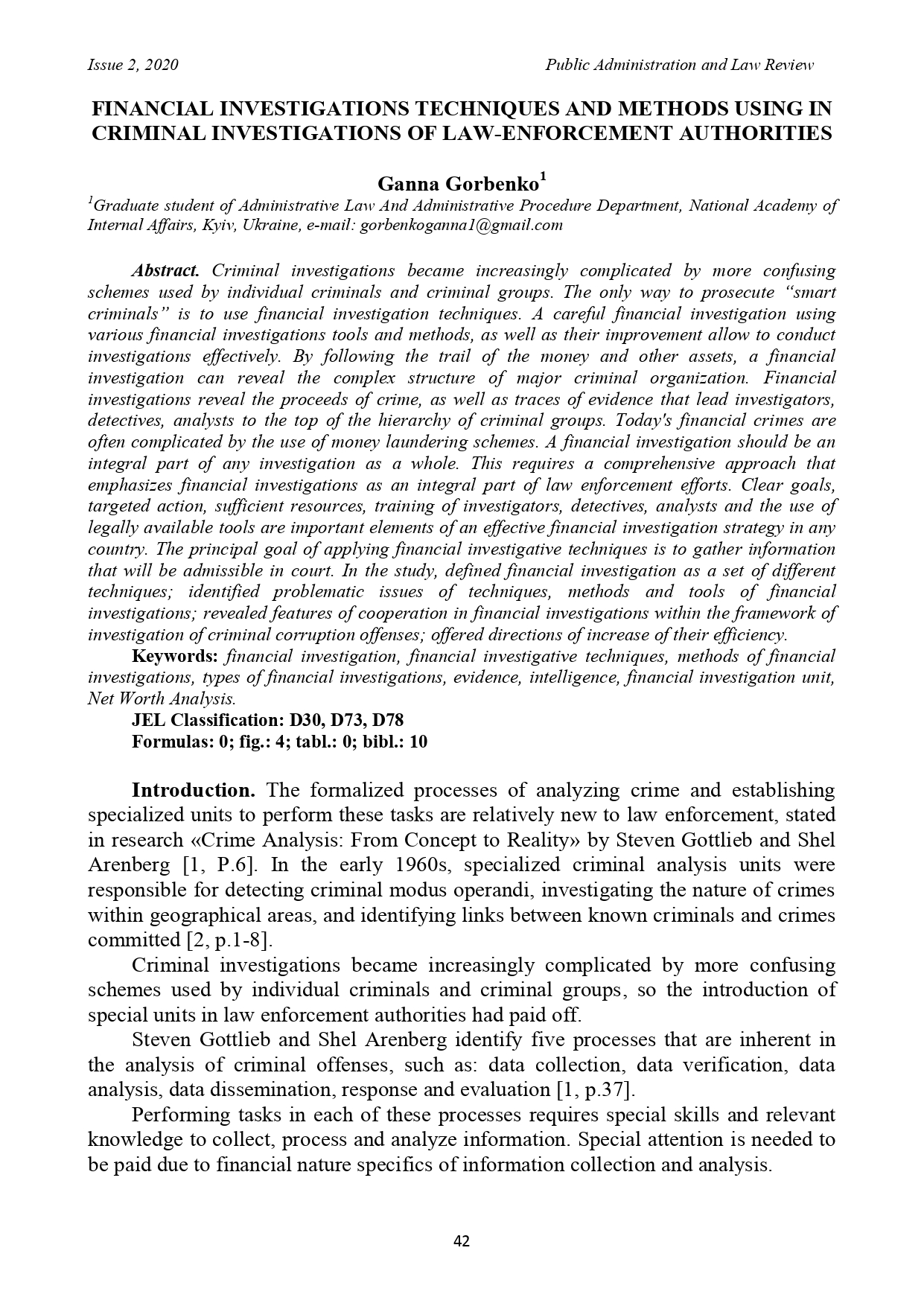FINANCIAL INVESTIGATIONS TECHNIQUES AND METHODS USING IN CRIMINAL INVESTIGATIONS OF LAW-ENFORCEMENT AUTHORITIES
DOI:
https://doi.org/10.36690/2674-5216-2020-2-42Keywords:
financial investigation, financial investigative techniques, methods of financial investigations, types of financial investigations, evidence, intelligence, financial investigation unit, Net Worth AnalysisAbstract
Criminal investigations became increasingly complicated by more confusing schemes used by individual criminals and criminal groups. The only way to prosecute “smart criminals” is to use financial investigation techniques. A careful financial investigation using various financial investigations tools and methods, as well as their improvement allow to conduct investigations effectively. By following the trail of the money and other assets, a financial investigation can reveal the complex structure of major criminal organization. Financial investigations reveal the proceeds of crime, as well as traces of evidence that lead investigators, detectives, analysts to the top of the hierarchy of criminal groups. Today's financial crimes are often complicated by the use of money laundering schemes. A financial investigation should be an integral part of any investigation as a whole. This requires a comprehensive approach that emphasizes financial investigations as an integral part of law enforcement efforts. Clear goals, targeted action, sufficient resources, training of investigators, detectives, analysts and the use of legally available tools are important elements of an effective financial investigation strategy in any country. The principal goal of applying financial investigative techniques is to gather information that will be admissible in court. In the study, defined financial investigation as a set of different techniques; identified problematic issues of techniques, methods and tools of financial investigations; revealed features of cooperation in financial investigations within the framework of investigation of criminal corruption offenses; offered directions of increase of their efficiency.
Downloads
References
Crime Analysis: From Concept to Reality/By Steven Gottlieb and Shel Arenberg Edited By Stephen Busack, Ph.D. // Office of Criminal Justice Planning Edition. 1991.
Richard G. Grassie // Crime Analysis Executive Manual (U.S. Department of Justice. Law Enforcement Assistance Administration. April 1977). pp. 1-8 through 1-11.
United State DOJ Financial Investigation Guide// Gerald E. McDowell, Chief Asset Forfeiture and Money Laundering Section Criminal Division U.S. Department of Justice (June 1998).
Williams, Howard E..; Investigating White-collar Crime : Embezzlement and Financial Fraud , 2006.
Analysis of Financial Statements/Meaning, Significance and Objectives of Financial Analysishttps://www.toppr.com/guides/accountancy/analysis-of-financial-statements/meaning-significance-objectives-financial-analysis.
Criminal Intelligence. Manual for Analysts// United Nations Office On Drugs And Crime. Vienna/New York, 2011.
Module 4. Planning Investigations: Investigation of Corruption and Money Laundering (adopted from the Handbook for Practitioners on Asset Recovery under StAR Initiative) Retrieved from: http://pubdocs.worldbank.org/en/ 220301427730119930/ AML-Module-4.pdf.
Handbook (First Part) - Best Practices in Investigating and Prosecuting Corruption Using Financial Flow Tracking Techniques and Financial Intelligence// 18th Anti-Corruption and Transparency Experts’ Working Group Meeting Ningbo, China (20 February 2014).
FATF, Operational Issues. Financial Investigation Guidance, June 2012, p. 11; UNODC (United Nations Office on Drugs and Crime) (2004), Practical Anti-Corruption Measures for Prosecutors and Investigators, Vienna, Austria, p. 54, Retrieved from: www.unodc.org/pdf/crime/corruption/Handbook.pdf.
Andrew P. Ross & Mark S. Warshavsky (2015). The Net Worth Method. Retrieved from: https://www.gettrymarcus.com/wp-content/uploads/2015/09/Insight1-The-Net-Worth-Method-revised.pdf.

Downloads
Published
How to Cite
Issue
Section
License
Copyright (c) 2020 Scientific Center of Innovative Researches OÜ

This work is licensed under a Creative Commons Attribution 4.0 International License.





